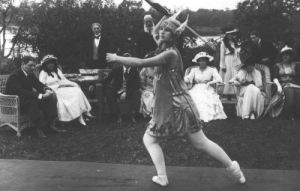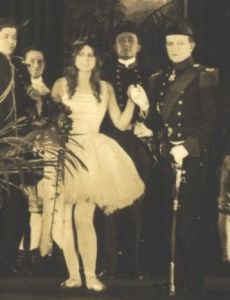Being the fan that I am (both of Cade and silent film), I couldn’t just let Mary Ann Cade go that easily after delivering her recent silent film news — I had to ask her about her extraordinary collecting efforts regarding another silent film actress, Valda Valkyrien. As always, Cade graciously accepted.
Valkyrien fascinated me when I first saw her photo in the book The Pictorial History of the Silent Screen by Daniel C. Blum.
fascinated me when I first saw her photo in the book The Pictorial History of the Silent Screen by Daniel C. Blum.

She does not look like any other silent star of the period. She has an ethereal almost angelic quality that radiates from her photos and looks quite different from other actresses. The photo got me to looking into her history and her film product as well.
When I started checking into her background, I only knew of one surviving film, her last called Shattered Dreams aka Bolshevism on Trial (1919) available for purchase through Grapevine Video. But perseverance and repeated inquiries have resulted in locating several other films.
Since Valkyrien made films in Denmark before coming to the U.S. in 1914, I started researching her films through my contacts at the Danish Film Institute. They informed me that two or three films in which she is a minor player survive in their archive, and that one of them, Circus Catastrophe, had been released in 2007 on DVD because it starred Danish matinee idol Valdemar Psilander. The only place to get this film is through the DFI archive, so it is really a very isolated title.
Most of Valkyrien’s films exist only in fragmentary form or survive only via movie still photographs. Here are some surviving images from The Valkyrie (1915) which show just how beautiful the actress was:





These next two movie still photos are from De Uheldige Friere and Guvernørens Datter, respectively; both are from 1912.)


The DFI archive sent me Den Staerkeste aka Vanquished (1912) and Dødsangstens Maskespil aka A Drama on the Ocean (1912) from their archive, but these are not available to the general public and Valkyrien, again, is a minor player in both.
Youth (1915), her first US film and starring part exists in the British Film Institute archive. I have had no luck in obtaining a copy thus far, but keep hoping.
Silas Marner (1916), is a partial surviving film from the Library of Congress and I was fortunate, as I mentioned, to get a copy. I received my copy from Ned Thanhouser; his grandfather, Edwin Thanhouser, started the Thanhouser production company. This shortened version of Silas Marner, the only one known to exist, was released by Thanhouser in October of 2009 on The Thanhouser Collection DVD Volumes 10, 11 & 12. Valkyrien is a supporting player in this one.
The Hidden Valley (1916), another Thanhouser release, was a starring role for Valkyrien and was thought to be a lost film.

In early 2009, while researching fragments which turned out to be for another film (stay tunned for another post!), I contacted the Library of Congress. They checked the FIAF database (paid filmography database in which you have to be a member to access the information) and stated that Screensound Australia might hold some footage of it. Screensound then sent these two pieces of film from The Hidden Valley:


And Screensound mentioned that they have something that indicates Florence LaBadie, the queen of the Thanhouser lot, was part of the cast. Ms. LaBadie was the reigning box office queen for the studio and Ned Thanhouser could find no records of her ever appearing in the cast, so he is intrigued as well. Ms. LaBadie died from injuries sustained in an auto accident in 1917 and her death was one of the events that eventually caused the studio to shut down.

We are still working on finding more Hidden Valley footage as well as determining if Ms. LaBadie was a cast member.
Since that time, we also have found Diana (1916), a Pluragraph release which is part of an Unknown Cinema box set release. However, the version Screensound has, from the Library of Congress, is a much shorter version of the film than the nearly complete print the Cineteca del Fruili sent me. I have been in touch with the Library of Congress to see if they want a more complete copy for their archive.
Another of Valkyrien’s starring vehicles is reputed to be in a private collection and we are making every effort to obtain the film from the collector, but so far we are running in circles. I keep hoping, though…
And we’re still working on a couple of silent films that may exist but I don’t have confirmation of the facts as of yet.
In other words, stay tunned to see what Cade & the crew dedicated to Valda Valkyrien dig up!

* Here’s the briefest of bios on silent film actress Valda Valkyrien:
 Born Adele Eleonore Freed in 1894 or 1895, she began her career as a performer as a prima ballerina in the Royal Danish Ballet performing under the stage name Valda Valkyrien. She began appearing in motion pictures for Nordisk Film productions of Copenhagen in 1912, and married Danish nobleman Baron Hrolf von Dewitz, becoming Baroness von Dewitz, in 1914 before making films in the United States.
Born Adele Eleonore Freed in 1894 or 1895, she began her career as a performer as a prima ballerina in the Royal Danish Ballet performing under the stage name Valda Valkyrien. She began appearing in motion pictures for Nordisk Film productions of Copenhagen in 1912, and married Danish nobleman Baron Hrolf von Dewitz, becoming Baroness von Dewitz, in 1914 before making films in the United States.
You can find more at FindAGrave, at the Danish Wikipedia, at Danskefilm.dk and the Danish Film Institute (to assist you, the Danish links are via Google’s translate).
Photo Credits, in order of appearance:
1917 photo of Valkyrien, from The Pictorial History of the Silent Screen by Daniel C. Blum.
Images/film stills (5) of Valda Valkyrien (billed as Baroness von Dewitz) in The Valkyrie (1915), from the film collection of Mary Ann Cade.
Valkyrien in De Uheldige Friere, courtesy of Mary Ann Cade.
Valkyrien in Guvernørens Datter, also from Mary Ann Cade.
Valda Valkyrien, photo from The Hidden Valley (listed as a Pathe film), also from The Pictorial History of the Silent Screen by Daniel C. Blum.
Pieces of film (2) from The Hidden Valley (1916), from Mary Ann Cade.
Florence La Badie movie card, from a series of antique movie cards with pink borders, circa 1915, courtesy Cliff Aliperti.
Valkyrien in The Valkyrie (last 2 photos), also from the collection of Mary Ann Cade.
 You’re likely going to think I’m insane with the number of cookie cutter posts I’m about to make — and by that, I mean posts about vintage cookie cutters, not posts that are all the same lol.
You’re likely going to think I’m insane with the number of cookie cutter posts I’m about to make — and by that, I mean posts about vintage cookie cutters, not posts that are all the same lol. I began with the vintage aluminum self-handled cookie cutters in that “tin” color, but quickly ended up with the vintage copper colored aluminum cookie cutters too.
I began with the vintage aluminum self-handled cookie cutters in that “tin” color, but quickly ended up with the vintage copper colored aluminum cookie cutters too.






























































































